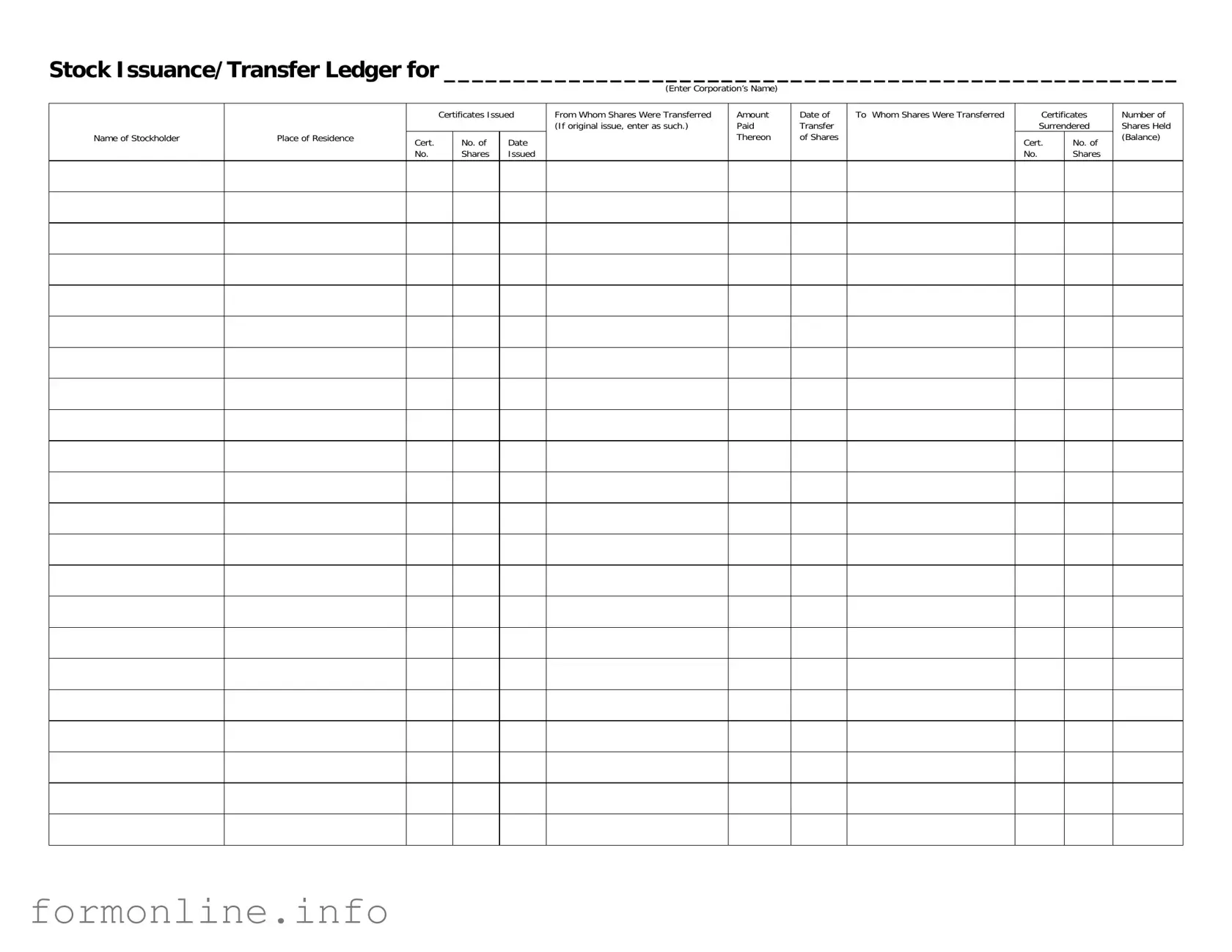The Stock Transfer Ledger is similar to a Shareholder Register. A Shareholder Register is a record that lists all the shareholders of a corporation, along with their contact information and the number of shares they own. This document is essential for maintaining accurate ownership records and ensuring that shareholders receive their dividends and voting rights. Like the Stock Transfer Ledger, it tracks changes in ownership, helping to keep the corporation informed about who holds its shares.
Another document that resembles the Stock Transfer Ledger is the Certificate of Stock. This certificate serves as proof of ownership for shares in a corporation. It includes details such as the shareholder's name, the number of shares owned, and the corporation's name. While the Stock Transfer Ledger records transactions and transfers, the Certificate of Stock represents the actual ownership of those shares. Both documents work together to maintain clear records of ownership.
The Dividend Record is also similar to the Stock Transfer Ledger. This document tracks the distribution of dividends to shareholders. It lists the shareholders, the number of shares they own, and the dividends they receive. Just as the Stock Transfer Ledger maintains a record of share ownership, the Dividend Record ensures that dividends are paid accurately and fairly based on the number of shares held by each shareholder.
The Corporate Bylaws document shares similarities with the Stock Transfer Ledger as well. Bylaws outline the rules and procedures for the corporation, including how shares can be transferred. They provide guidelines for the management of the corporation and the rights of shareholders. While the Stock Transfer Ledger records specific transactions, the Bylaws establish the framework within which those transactions occur.
In addition to the documents already discussed, it's important to consider the Mobile Home Bill of Sale, which also plays a crucial role in the transfer of ownership. This legal form serves to ensure that all terms of the transaction are officially recorded, thereby protecting the interests of both the buyer and the seller in a mobile home sale.
Another comparable document is the Stock Option Agreement. This agreement grants individuals the right to purchase shares at a predetermined price. It includes details about the number of options granted and the terms of exercise. Like the Stock Transfer Ledger, it tracks ownership interests, but it focuses on options rather than actual shares. Both documents are important for managing equity within a corporation.
The Subscription Agreement also shares characteristics with the Stock Transfer Ledger. This document is used when investors agree to purchase shares in a corporation. It outlines the terms of the investment, including the number of shares and the price. While the Stock Transfer Ledger records the actual transfer of shares, the Subscription Agreement captures the initial intent to acquire those shares, making it a vital part of the share issuance process.
The Annual Report can be likened to the Stock Transfer Ledger in that it provides a comprehensive overview of the corporation's performance, including information about its shareholders. The report often includes details about share ownership and any changes that occurred during the year. While the Stock Transfer Ledger focuses on individual transactions, the Annual Report summarizes the overall state of the corporation, including its shareholders.
Lastly, the Meeting Minutes document is similar in that it records the proceedings of shareholder meetings, including discussions about share transfers and ownership issues. Meeting Minutes capture the decisions made by shareholders, including any resolutions regarding stock transfers. While the Stock Transfer Ledger tracks the actual transfers, the Meeting Minutes provide context and documentation of the discussions that led to those transfers.

